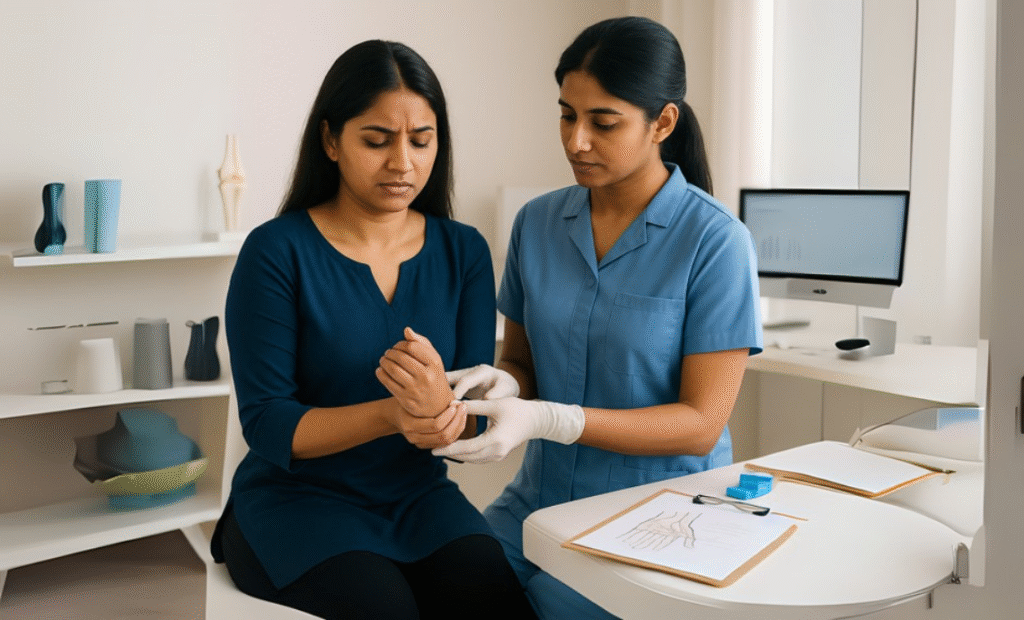De Quervain Tenosynovitis, commonly known as wrist tendon inflammation, can make daily activities like typing, lifting, or even holding objects painful and frustrating. However, with the right guidance, recovery is possible without invasive procedures. In this blog, we discuss effective De Quervain Tenosynovitis treatment strategies and highlight how physiotherapy can play a crucial role in faster and safer recovery. By following these De Quervain Tenosynovitis treatment approaches, patients can regain wrist function, reduce pain, and prevent recurrence.
1. Understanding De Quervain Tenosynovitis
De Quervain Tenosynovitis occurs when the tendons on the thumb side of the wrist become inflamed, often due to repetitive motions or overuse. Early diagnosis is essential to prevent chronic pain and limited mobility. For more information on the causes, symptoms, and treatments of this condition, visit Cleveland Clinic’s guide on De Quervain’s Tendinosis.
A physiotherapy doctor typically performs a detailed assessment to identify the severity of tendon inflammation and associated functional limitations. Following De Quervain Tenosynovitis treatment guidelines ensures that the recovery plan is tailored to your specific needs, minimizing discomfort while promoting tendon healing.
2. Targeted Physiotherapy for Wrist Pain
One of the most recommended methods for De Quervain Tenosynovitis treatment is physiotherapy, which addresses the underlying inflammation and strengthens surrounding muscles. Physiotherapy for wrist pain involves exercises that improve mobility, reduce swelling, and restore grip strength.
For example, gentle stretching of the thumb and wrist can relieve tension, while progressive strengthening exercises stabilize the tendons. Following these De Quervain Tenosynovitis treatment strategies under professional supervision helps prevent further damage and ensures faster recovery. Additionally, incorporating exercises for wrist pain relief as part of your daily routine supports long-term healing.
3. Role of Orthopedic Physiotherapy
Orthopedic physiotherapy focuses on musculoskeletal injuries and is highly effective for tendon-related conditions like De Quervain Tenosynovitis. By combining manual therapy, joint mobilization, and guided strengthening exercises, orthopedic techniques enhance tendon healing while reducing pain.
Following De Quervain Tenosynovitis treatment plans that include orthopedic physiotherapy helps restore wrist function efficiently. Using rehabilitation exercises specifically designed for tendon recovery can accelerate healing and prevent future flare-ups. Patients following expert advice often experience improved mobility, reduced discomfort, and faster return to daily activities.
4. Physiotherapy at Home for Consistent Healing
Recovery is most effective when exercises are practiced consistently. A physiotherapy doctor may recommend physiotherapy at home programs tailored to your condition. These home routines often include thumb stretches, wrist mobility exercises, and low-impact strengthening techniques.
Incorporating De Quervain Tenosynovitis treatment strategies at home ensures continuity of care, especially when regular clinic visits are not feasible. Applying De Quervain Tenosynovitis treatment exercises at home reinforces in-clinic progress and accelerates healing. By combining physiotherapy for wrist pain with home-based rehabilitation routines, patients can achieve faster results while maintaining safety and comfort.
5. Holistic Approach: Lifestyle and Ergonomic Adjustments
Recovery is not limited to exercises alone. Experts recommend integrating ergonomic adjustments and lifestyle changes to support De Quervain Tenosynovitis treatment. Proper wrist positioning during work, taking breaks from repetitive motions, and using supportive devices like wrist splints can prevent strain and promote healing.
Combining these strategies with physiotherapy guidance ensures that recovery is sustainable. Following De Quervain Tenosynovitis treatment advice while incorporating benefits of physiotherapy enhances overall wrist function, reduces pain, and prevents recurrence. Patients who follow these holistic approaches experience long-term improvements in both mobility and daily activity performance.
6. Additional Tips for Faster Recovery
- Pain Management: Use ice packs or anti-inflammatory techniques as recommended by your physiotherapy doctor.
- Regular Monitoring: Track your progress to adjust exercises according to your recovery stage.
- Mental Wellness: Managing stress and maintaining proper sleep improves healing outcomes.
- Nutrition: A balanced diet supports tissue repair and overall recovery.
These additional tips complement De Quervain Tenosynovitis treatment plans, making the recovery process more effective and enjoyable. Applying these treatment strategies alongside rehabilitation exercises and expert physiotherapy advice ensures a holistic and efficient recovery.
Conclusion
Effective recovery from De Quervain Tenosynovitis is achievable with a structured and expert-guided approach. At Violet Physio, we combine personalized assessment, orthopedic physiotherapy, home-based exercises, and ergonomic lifestyle adjustments to accelerate healing while preventing future flare-ups.
By consistently following De Quervain Tenosynovitis treatment recommendations from Violet Physio, patients can regain wrist strength, reduce pain, and enjoy daily activities without discomfort. Incorporating physiotherapy at home, practicing exercises for wrist pain relief, and leveraging expert physiotherapy advice and rehabilitation exercises ensures optimal recovery outcomes. Understanding the benefits of physiotherapy and applying these strategies consistently transforms the healing journey into a faster, safer, and more effective process.
Take charge of your recovery today with these expert-backed De Quervain Tenosynovitis treatment approaches at Violet Physio and restore wrist mobility and strength efficiently.


